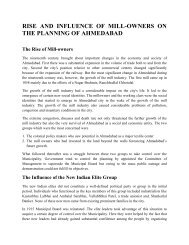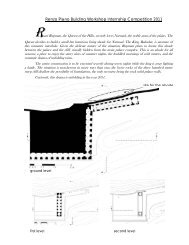the City Edge
the City Edge
the City Edge
You also want an ePaper? Increase the reach of your titles
YUMPU automatically turns print PDFs into web optimized ePapers that Google loves.
Change in <strong>the</strong> nature of walls : <strong>the</strong> intramural<br />
zone.<br />
As <strong>the</strong> power of cannons grew during <strong>the</strong> 16th and 17th century,<br />
medieval walls became obsolete as <strong>the</strong>y were too thin to offer any<br />
realistic protection against prolonged bombardment. Most walls<br />
were torn down, <strong>the</strong> material was used in building of towers.<br />
The intramural zone was <strong>the</strong> least desirable area to build. This<br />
gave opportunity for squatter settlements and makeshift shanties<br />
come against <strong>the</strong> wall.<br />
In China, <strong>the</strong> earlier walls that were built out of earth were<br />
massive affairs. The poor built shelters attached to it, as well as<br />
carved niches which were cave-like in nature.<br />
Walls in Chang „an, china. Artillery platforms built in<br />
between <strong>the</strong> towers- largely increased unbuilt space<br />
between city and <strong>the</strong> walls. .<br />
THE CITY EDGE<br />
<strong>City</strong> walls in Beijing, China: extremely massive.
















